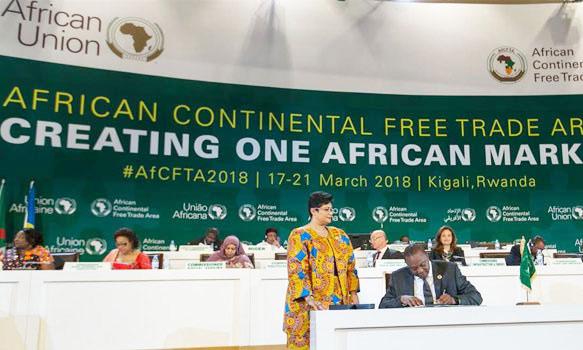
4 minute read
African Continental Free Trade Area: Co-operatives Fostering Implementation
by eric
By June Njoroge
Advertisement
The African Continental Free Trade Area (AfCFTA) is a game changer in the African regional and international trade; projected upon completion to become the largest free trade area in the world, since the establishment of the World Trade Organization (WTO).
The Co-operative business model was highlighted as instrumental and an invaluable conduit in the fulfilment of this endeavor, with African Co-operatives identified as key vehicles in the successful realization of this new economic path for the continent.
AfCFTA creates a single continental market for goods and services as well as Customs Union, with free movement of capital and business persons unleashing great potentials and opportunities which include, reduction in tariffs, better co-ordination within the supply and demand chains, improvement of agricultural value chains among many more. The estimated value of Co-op to Co-op trade in 2013 was US$ 10 billion (ICA 2015).
The Dalberg (WTO, 2015) analysis shows that the opportunity for Co-op to Coop trade could increase to US$13 billion and realistically achievable to US$18 billion.
The International Co-operative Alliance Africa (ICA-Africa) held an online regional conference in mid-October on ‘Fostering Implementation of the African Continental Free Trade Area through Co-operatives,’ with key government officials, Co-operative leaders, partners and other stakeholders.
The conference was aimed at identifying potential synergies, issues, opportunities and benefits for African Co-operatives, emanating from the implementation of AfCFTA; spurring and reengineering co-operative organizations in Africa to engage in Co-op to Co-op trade; enhancing Co-operative network and building the Cooperative ecosystem for intra-trade through AfCFTA; identifying the importance of leveraging on technology to enhance Co-op to Co-op trade in Africa.
In addition, it was meant to share knowledge that enables Co-operatives and other stakeholders in Africa; to engage effectively in advocacy and policy dialogue mechanisms to support the negotiations and subsequent implementation of AfCFTA.
The regional Director of ICA Africa, Dr. Sifa Chiyoge, shed light on the interface between AfCFTA and how African cooperatives can leverage and engage in intra-African trade.
ILO Co-op was a chief participant and the manager Ms Simel Esim, highlighted findings from an ILO assessment, on the potential of co-operatives in the SADC region to engage in imports and exports, with a focus on the agricultural sector.
She noted that trade was deeply connected to Co-operative development, underlining how co-operative development programmes can be integral in unlocking the potential of Cooperatives; towards becoming better integrated into global supply chains.
She further noted that cooperative to co-operative trade, can be a socially innovative model toward more inclusive, transparent and sustainable global supply chains, aligned with SDG 12 on sustainable consumption and production.
She pointed out that during COVID-19 pandemic, shortening supply chains by establishing direct purchasing
lines between producer and consumer co-operatives, can help reduce the risk of inflated food prices and improve food security of local communities. Co-operation among Co-
Key Benefits of AfCFTA to Cooperatives: • Increase in the economies of scale and access to cheaper raw materials and intermediate inputs. • Better conditions for regional value chains and integration into global value chains. • Catalyzing the transformation of African economies towards greater utilization of technology and knowledge. • Facilitating both intra-
African and external direct capital flows to African countries • Creating a labour market and a demand pull notes that the agreement could
throughout the continent.
Governments were called upon to go beyond the usual strategies for implementation of policies; creating a conducive environment and enact enabling policies to support small to medium- sized enterprises(SMEs) and Co-operatives, as they form the majority of the African economies.

operatives is also essential as it will contribute to the full realization of the AfCFTA. Albeit delayed by the Covid-19 pandemic, the implementation of AfCFTA, is set to begin anew in January 2021, with a focus first on easing trade for SMEs, which account for 90% of jobs created on the continent.
According to the United Nations Economic Commission for Africa, AfCFTA will cover a market of more than 1.2 billion people and up to $3 trillion in combined GDP, when it comes to effect, with the potential to increase intra-African trade by over 50%.
During the 12th ICAAfrica African Ministerial Co-operative Conference (AMCCO) held in AbujaNigeria in October 2018; the Ministers responsible for cooperative development in Africa, committed to continue with the promotion of the Cooperative business model, to foster economic growth in Africa.
In order to ensure that Cooperatives can benefit, its crucial for the movement to understand what the AfCFTA future negotiations will cover. They should also ensure their voice is heard, as governments craft and operationalize the agreement.
The 2019 issue of the World Cooperative monitor, published by the ICA and Euricse, paints a picture of the scale and strength, of the global cooperative movement.
The Economic Commission for Africa (UNECA) suggests that AfCFTA, has the potential to boost intra-African trade by 52.3% by eliminating import duties and to double this trade, if non-tariff barriers are also reduced.
Headquartered in Accra, Ghana, the AfCFTA Secretariat, is expected to lead the initiative and implementation of the agreement’s aspirations through strategic collaborations, stakeholders’ engagement and resource mobilization, as Africans move towards achieving Agenda 2063 of the Africa we want.
The AfCFTA will boost intraAfrican trade by providing a more comprehensive and mutually beneficial trade agreement among member states; covering trade in goods, services, investment, intellectual property rights and competitive policies.










